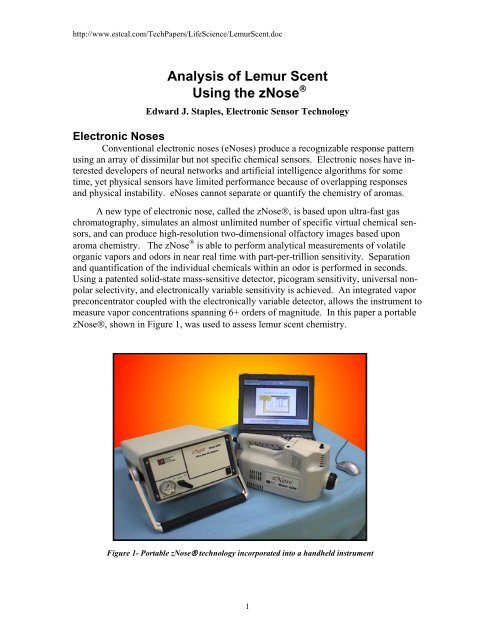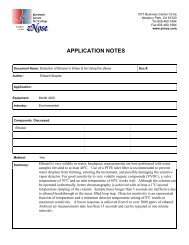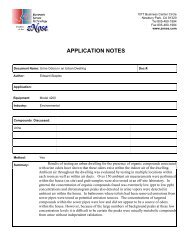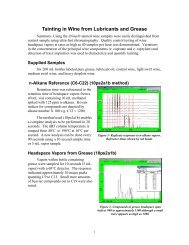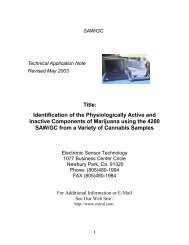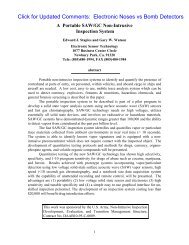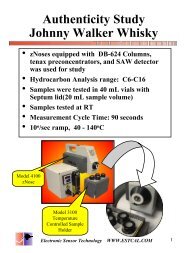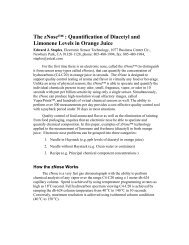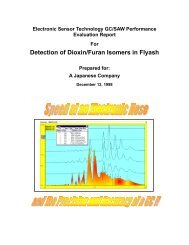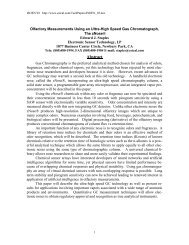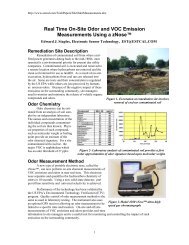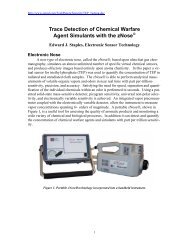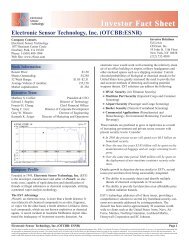Analysis of Lemur Scent Using the zNose - Electronic Sensor ...
Analysis of Lemur Scent Using the zNose - Electronic Sensor ...
Analysis of Lemur Scent Using the zNose - Electronic Sensor ...
You also want an ePaper? Increase the reach of your titles
YUMPU automatically turns print PDFs into web optimized ePapers that Google loves.
http://www.estcal.com/TechPapers/LifeScience/<strong>Lemur</strong><strong>Scent</strong>.doc<br />
<strong>Analysis</strong> <strong>of</strong> <strong>Lemur</strong> <strong>Scent</strong><br />
<strong>Using</strong> <strong>the</strong> <strong>zNose</strong> ®<br />
Edward J. Staples, <strong>Electronic</strong> <strong>Sensor</strong> Technology<br />
<strong>Electronic</strong> Noses<br />
Conventional electronic noses (eNoses) produce a recognizable response pattern<br />
using an array <strong>of</strong> dissimilar but not specific chemical sensors. <strong>Electronic</strong> noses have interested<br />
developers <strong>of</strong> neural networks and artificial intelligence algorithms for some<br />
time, yet physical sensors have limited performance because <strong>of</strong> overlapping responses<br />
and physical instability. eNoses cannot separate or quantify <strong>the</strong> chemistry <strong>of</strong> aromas.<br />
A new type <strong>of</strong> electronic nose, called <strong>the</strong> <strong>zNose</strong>®, is based upon ultra-fast gas<br />
chromatography, simulates an almost unlimited number <strong>of</strong> specific virtual chemical sensors,<br />
and can produce high-resolution two-dimensional olfactory images based upon<br />
aroma chemistry. The <strong>zNose</strong> ® is able to perform analytical measurements <strong>of</strong> volatile<br />
organic vapors and odors in near real time with part-per-trillion sensitivity. Separation<br />
and quantification <strong>of</strong> <strong>the</strong> individual chemicals within an odor is performed in seconds.<br />
<strong>Using</strong> a patented solid-state mass-sensitive detector, picogram sensitivity, universal nonpolar<br />
selectivity, and electronically variable sensitivity is achieved. An integrated vapor<br />
preconcentrator coupled with <strong>the</strong> electronically variable detector, allows <strong>the</strong> instrument to<br />
measure vapor concentrations spanning 6+ orders <strong>of</strong> magnitude. In this paper a portable<br />
<strong>zNose</strong>®, shown in Figure 1, was used to assess lemur scent chemistry.<br />
Figure 1- Portable <strong>zNose</strong>® technology incorporated into a handheld instrument<br />
1
http://www.estcal.com/TechPapers/LifeScience/<strong>Lemur</strong><strong>Scent</strong>.doc<br />
How <strong>the</strong> <strong>zNose</strong> Quantifies <strong>the</strong> Chemistry <strong>of</strong> Odors<br />
A simplified diagram <strong>of</strong> <strong>the</strong> <strong>zNose</strong> system shown in Figure 2 consists <strong>of</strong> two sections.<br />
One section uses helium gas, a capillary tube (GC column) and a solid-state detector.<br />
The o<strong>the</strong>r section consists <strong>of</strong> a heated inlet and pump, which samples ambient air.<br />
Linking <strong>the</strong> two sections is a “loop” trap, which acts as a preconcentrator when placed in<br />
<strong>the</strong> air section (sample position) and as an injector when placed in <strong>the</strong> helium section (inject<br />
position). Operation is a two step<br />
process. Ambient air (odor) is first sampled<br />
and organic vapors collected (preconcentrated)<br />
on <strong>the</strong> trap. After sampling <strong>the</strong><br />
trap is switched into <strong>the</strong> helium section<br />
where <strong>the</strong> collected organic compounds are<br />
injected into <strong>the</strong> helium gas. The organic<br />
compounds pass through a capillary column<br />
with different velocities and thus individual<br />
chemicals exit <strong>the</strong> column at characteristic<br />
times. As <strong>the</strong>y exit <strong>the</strong> column <strong>the</strong>y are<br />
detected and quantified by a solid state detector.<br />
An internal high-speed gate array microprocessor<br />
controls <strong>the</strong> taking <strong>of</strong> sensor<br />
data which is transferred to a user interface<br />
or computer using an RS-232 or USB connection.<br />
Odor chemistry, shown in Figure<br />
3, can be displayed as a sensor spectrum or<br />
a polar olfactory image <strong>of</strong> odor intensity vs<br />
2<br />
Figure 2- Simplified diagram <strong>of</strong> <strong>the</strong> <strong>zNose</strong><br />
showing an air section on <strong>the</strong> right and a helium<br />
section on <strong>the</strong> left. A loop trap preconcentrates<br />
organics from ambient air in <strong>the</strong><br />
sample position and injects <strong>the</strong>m into <strong>the</strong> helium<br />
section when in <strong>the</strong> inject position.<br />
retention time. Calibration is accomplished using a single n-alkane vapor standard. A<br />
library <strong>of</strong> retention times <strong>of</strong> known chemicals indexed to <strong>the</strong> n-alkane response (Kovats<br />
indices) allows for machine independent measurement and compound identification.<br />
Figure 3- <strong>Sensor</strong> response to n-alkane vapor standard, here C6-C14, can be<br />
displayed as sensor output vs time or its polar equivalent olfactory image.
http://www.estcal.com/TechPapers/LifeScience/<strong>Lemur</strong><strong>Scent</strong>.doc<br />
Chemical <strong>Analysis</strong> (Chromatography)<br />
The time derivative <strong>of</strong> <strong>the</strong> sensor<br />
spectrum (Figure 3) yields <strong>the</strong><br />
spectrum <strong>of</strong> column flux, commonly<br />
referred to as a chromatogram. The<br />
chromatogram response (Figure 4) <strong>of</strong><br />
n-alkane vapors (C6 to C14) provides<br />
a set <strong>of</strong> reference retention times.<br />
Graphically defined regions, shown<br />
as red bands, provide a method<br />
dependent reference time base against<br />
which subsequent chemical responses<br />
can be compared and indexed. As an<br />
example, a response midway between<br />
C10 and C11 would have a retention<br />
time index <strong>of</strong> 1050.<br />
Sensitivity<br />
Figure 4 - Chromatogram <strong>of</strong> n-alkane vapors C6 to C14).<br />
Measurement sensitivity is controlled by vapor sample time and SAW detector<br />
temperature. <strong>Using</strong> <strong>the</strong> variable sensitivity <strong>of</strong> <strong>the</strong> SAW detector it was possible to<br />
achieve ppb and even ppt sensitivity by lowering <strong>the</strong> detector temperature. It is also possible<br />
to prevent overloading by raising <strong>the</strong> temperature <strong>of</strong> <strong>the</strong> detector. The concentration<br />
in counts (peak area) <strong>of</strong> a typical volatile organic compound as a function <strong>of</strong> detector<br />
temperature is shown in figure 12.<br />
Figure 5- The exponential temperature dependence <strong>of</strong> SAW detector allows electronically variable sensitivity<br />
to be achieved over a wide range <strong>of</strong> vapor concentrations.<br />
3
http://www.estcal.com/TechPapers/LifeScience/<strong>Lemur</strong><strong>Scent</strong>.doc<br />
<strong>Lemur</strong> <strong>Scent</strong><br />
Prosimians, which retain a suite <strong>of</strong> physical characteristics that have been lost in<br />
<strong>the</strong> "higher" primates (monkeys, apes and man), are <strong>the</strong> closest living analogs to man’s<br />
ancient primate ancestors who lived during <strong>the</strong> Eocene epoch (about 55 million years<br />
ago). Prosimians are <strong>of</strong>ten referred to as "lower"<br />
primates, as <strong>the</strong>y are simply characterized by<br />
retention <strong>of</strong> certain body systems that are primitive<br />
relative to those possessed by higher primates. For<br />
instance, prosimians tend to rely more heavily on<br />
<strong>the</strong> sense <strong>of</strong> smell. Male ring-tailed lemurs have<br />
darkly colored scent glands on <strong>the</strong> inside <strong>of</strong> <strong>the</strong>ir<br />
wrists with a spur-like fingernail, usually referred<br />
to as a horny spur, overlay on each. Males also<br />
have scent glands on <strong>the</strong>ir chests, just above <strong>the</strong><br />
collarbone and close to <strong>the</strong> armpit. Although prosimians<br />
are greatly olfaction-oriented, little is<br />
known about <strong>the</strong> specifics <strong>of</strong> how <strong>the</strong>y use scent to<br />
communicate<br />
Figure 6- Lumur.<br />
1 . In this preliminary study we<br />
examine 3 samples <strong>of</strong> gland secretions from<br />
lemurs using an ultra-high speed gas<br />
chromatograph. The results indicate that a portable<br />
electronic nose based upon gas chromatography<br />
might be used in <strong>the</strong> field to study scent marks as a<br />
way <strong>of</strong> determining species, sex, and reproductive<br />
status<br />
Communication is achieved by both olfactory and vocal means 2 . Olfactory communication<br />
is extremely important and is made possible by <strong>the</strong> scent glands located at <strong>the</strong><br />
wrist throat. This type <strong>of</strong> communication is used for transmitting physical state, location,<br />
and individual recognition. According to researchers at Duke University 3 when males<br />
mark, <strong>the</strong>y mark ei<strong>the</strong>r only with <strong>the</strong> wrist gland, or <strong>the</strong>y will go through a rubbing motion<br />
and mix <strong>the</strong> secretions <strong>of</strong> <strong>the</strong> shoulder gland with <strong>the</strong> secretions <strong>of</strong> <strong>the</strong> wrist gland,<br />
and <strong>the</strong>n deposit that. One <strong>of</strong> <strong>the</strong> big questions is whe<strong>the</strong>r <strong>the</strong>re's a difference between<br />
wrist marking and shoulder/wrist marking? What are <strong>the</strong> different messages encoded?<br />
Does <strong>the</strong> shoulder gland have a specific function in terms <strong>of</strong> message, or is it acting as<br />
sort <strong>of</strong> a fixative for <strong>the</strong> more volatile components <strong>of</strong> <strong>the</strong> wrist gland?<br />
1 R.A. Hayes, T.L. Morelli, P.C. Wright, Anogenital gland secretions <strong>of</strong> <strong>Lemur</strong> catta and Propi<strong>the</strong>cus verreauxi coquereli:<br />
A preliminary chemical examination, Am J Primatol 63:49-62, 2004<br />
2 Dugmore, S.J. and Evans, C.S. (1990) Discrimination <strong>of</strong> conspecific chemosignals by female ringtailed<br />
lemurs, <strong>Lemur</strong> catta L. In Macdonald, D.W., Muller-Schwarze, D. and Natynczuk, S.E. (eds), Chemical<br />
Signals in Vertebrates 5. Plenum Press, New York, pp. 360–36<br />
3 http://www.dukenews.duke.edu/2004/08/Drea<strong>Lemur</strong>scent_0804.html<br />
4
http://www.estcal.com/TechPapers/LifeScience/<strong>Lemur</strong><strong>Scent</strong>.doc<br />
<strong>Scent</strong> Testing Methods<br />
<strong>Scent</strong> samples from lemurs were collected by absorbing approximately 10 µliters <strong>of</strong><br />
scent liquid from <strong>the</strong> scent gland onto a small cotton ball which was immediately placed<br />
in a sealed 2 mL vial and stored at 0 o C<br />
until just before testing. Samples were<br />
prepared for testing by removing <strong>the</strong> cap<br />
<strong>of</strong> <strong>the</strong> 2 mL vial and transferring <strong>the</strong><br />
sample into a larger septa-sealed 40 mL<br />
vial which was <strong>the</strong>n heated to 60 o C using<br />
<strong>the</strong> two-zone vial heater shown in Figure<br />
7. <strong>Lemur</strong> scents were analyzed using (1)<br />
direct sampling with <strong>the</strong> <strong>zNose</strong>® and (2)<br />
indirect or remote sampling with a tenax<br />
filled sorption tube which was <strong>the</strong>n<br />
desorbed and measured with <strong>the</strong> <strong>zNose</strong> ® .<br />
Direct Sampling<br />
Figure 7- Direct sampling scent vapors using vial<br />
heater accessory<br />
Vapors in <strong>the</strong> vial (lemur scent)<br />
were directly sampled using a side-ported<br />
needle attached to <strong>the</strong> inlet <strong>of</strong> <strong>the</strong> <strong>zNose</strong> ® as shown in Figure 7. Sample time was typically<br />
5-10 seconds, which removed approximately 2-4 mL <strong>of</strong> headspace vapor. Following<br />
sampling <strong>the</strong> vapor sample was analyzed in 20 seconds using a dB-5 column ramped<br />
from 40 o to 140 o C at 5 o C/second. Replicate measurements could be performed every 1.5minute.<br />
Remote Sampling<br />
Although requiring an additional step and<br />
more time, sampling scent vapors with a small<br />
battery operated pump and preconcentrating in a<br />
sorbtion tube filled with 250 milligrams <strong>of</strong> tenax has<br />
several advantages. First is <strong>the</strong> convenience <strong>of</strong> using<br />
a small 12 oz pump and battery to collect vapors in<br />
<strong>the</strong> field from subjects. Second, a higher sample<br />
flow enables a much larger vapor sample to be<br />
preconcentrated and measurement sensitivity well<br />
into <strong>the</strong> ppt concentration range can be achieved.<br />
The <strong>zNose</strong> is equipped with a desorber<br />
interface which enables it to quickly remove<br />
preconcentrated vapors from a sample collection<br />
tube as shown in Figure 8. The collection tube is<br />
heated to approximately 200 o C and <strong>the</strong>n<br />
preconcentrated vapors are transferred in 10 seconds<br />
into <strong>the</strong> inlet <strong>of</strong> <strong>the</strong> <strong>zNose</strong> ® and chemically analyzed.<br />
5<br />
Figure 8- Remote sampler and desorbtion<br />
heater.
http://www.estcal.com/TechPapers/LifeScience/<strong>Lemur</strong><strong>Scent</strong>.doc<br />
Direct Sampling Results<br />
<strong>Scent</strong> samples were heated<br />
to 60 o C and sampled directly with<br />
<strong>the</strong> <strong>zNose</strong>®. Vertically <strong>of</strong>fset<br />
replicate chromatograms using<br />
different detector sensitivity<br />
settings (temperature) for <strong>the</strong><br />
three samples are shown in<br />
Figures 9-11.<br />
The most notable in all<br />
samples was a compound with a<br />
Kovats index <strong>of</strong> approximately<br />
1352. Also evident was a very<br />
volatile compound which had an<br />
index <strong>of</strong> 738. Trace amounts <strong>of</strong><br />
o<strong>the</strong>r compounds are shown in <strong>the</strong><br />
tabulated results adjacent to each<br />
chromatogram.<br />
Increasing sensitivity <strong>of</strong><br />
direct measurements by lowering<br />
detector temperature was<br />
sometimes difficult due to <strong>the</strong><br />
large amount <strong>of</strong> water vapor<br />
present which tended to overload<br />
<strong>the</strong> detector at low temperatures.<br />
Vertically <strong>of</strong>fset traces<br />
comparing each sample using a<br />
10 o C detector are shown in Figure<br />
12. Samples 1061 and 1097 were<br />
more alike than sample 1081.<br />
Figure 9- Direct sampling sample no 1061<br />
Figure 10- Direct sampling sample no. 1081<br />
Figure 11- direct sampling sample no. 1097.<br />
6
http://www.estcal.com/TechPapers/LifeScience/<strong>Lemur</strong><strong>Scent</strong>.doc<br />
Figure 12- Comparing samples analyzed using direct sampling and 10 o detector.<br />
Indirect Sampling<br />
Chromatograms <strong>of</strong> scent samples analyzed by first preconcentrating scent vapors<br />
with a tenax filled collection tube (remote sampler) followed by analysis using <strong>the</strong><br />
<strong>zNose</strong>® are shown in Figures 13-15. Water vapor in <strong>the</strong> desorbtion tubes was removed<br />
by passing 150 ccm <strong>of</strong> air through <strong>the</strong> tube at room temperature for 1 minute prior to desorbtion.<br />
As was seen in <strong>the</strong> previous direct sampling, <strong>the</strong> compound with a Kovats index<br />
<strong>of</strong> approximately 1352 again appears prominently. Samples 1061 and 1097 both<br />
show high concentrations <strong>of</strong> <strong>the</strong><br />
volatile compound with index <strong>of</strong><br />
740, however it is not present in<br />
sample no 1081. Trace amounts<br />
<strong>of</strong> o<strong>the</strong>r compounds are shown in<br />
<strong>the</strong> tabulated results adjacent to<br />
each chromatogram. Trace<br />
amounts <strong>of</strong> background organics<br />
from <strong>the</strong> vial and septa analyzed<br />
before <strong>the</strong> lemur scent sample<br />
was inserted are shown for comparison.<br />
Figure 13- 15 second sample <strong>of</strong> scent no 1061using remote<br />
sampler.<br />
7
http://www.estcal.com/TechPapers/LifeScience/<strong>Lemur</strong><strong>Scent</strong>.doc<br />
Figure 14- 15 second sample <strong>of</strong> scent no 1081using remote<br />
sampler<br />
Figure 15- 15-second sample <strong>of</strong> scent no 1097 using remote<br />
sampler.<br />
Selecting compounds in lemur scent, which are not present in background odors,<br />
can be used to create a virtual sensor array for lemur scent. The process is shown in Figure<br />
16 using 5 major compounds from <strong>the</strong> chromatogram <strong>of</strong> scent sample no 1061. The<br />
compounds are selected by placing graphical bands over <strong>the</strong> selected peaks (top). Although<br />
<strong>the</strong> actual chemical names <strong>of</strong> <strong>the</strong> compounds are not known it is convenient to<br />
label <strong>the</strong>m according to <strong>the</strong>ir unique Kovats indices e.g. lemur 741.<br />
The indices <strong>of</strong> <strong>the</strong> virtual sensors are defined by a peak file (table), which includes<br />
user specified response factors, and alarm levels in any convenient units. Once <strong>the</strong> virtual<br />
sensor array is defined a simplified user interface showing just a sensor panel is used<br />
to replace <strong>the</strong> chromatogram display.<br />
8
http://www.estcal.com/TechPapers/LifeScience/<strong>Lemur</strong><strong>Scent</strong>.doc<br />
Figure 16- <strong>Lemur</strong> virtual <strong>Sensor</strong> Array defined by scent no 1061<br />
9
http://www.estcal.com/TechPapers/LifeScience/<strong>Lemur</strong><strong>Scent</strong>.doc<br />
Summary<br />
Chemical pr<strong>of</strong>iles associated with <strong>the</strong> scent <strong>of</strong> lemurs can contain a complex cocktail<br />
<strong>of</strong> odorous substances. A preliminary analysis <strong>of</strong> 3 scent samples with <strong>the</strong> <strong>zNose</strong>®,<br />
an ultra-fast portable GC, has indicated high concentrations <strong>of</strong> a very volatile compound,<br />
index = 740, and a second much less volatile compound with an index <strong>of</strong> 1352. Trace<br />
levels <strong>of</strong> many o<strong>the</strong>r organic compounds were also detected.<br />
The <strong>zNose</strong>® is a new quantitative testing tool for in-situ vapor analysis and<br />
achieves near real time speed. It is particularly useful for many life science applications<br />
where real time in-situ biochemical measurements are needed. A remote sampler interface<br />
compliments scent measurements, increases sensitivity, and provides a simple tool<br />
for collecting scent samples in <strong>the</strong> field. Future work might be to use <strong>the</strong> <strong>zNose</strong> ® to<br />
quantify lemur scents and relate <strong>the</strong> findings to factors such as species, sex, and reproductive<br />
status. Real time measurements might prove useful in understanding lemur olfactory<br />
communication. It might also be used to measure <strong>the</strong> difference between wrist marking<br />
and shoulder/wrist marking, how different messages are encoded, and determine <strong>the</strong><br />
functions associated with specific scent glands.<br />
10


